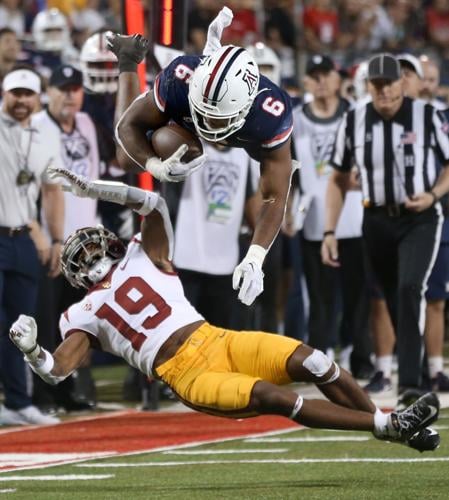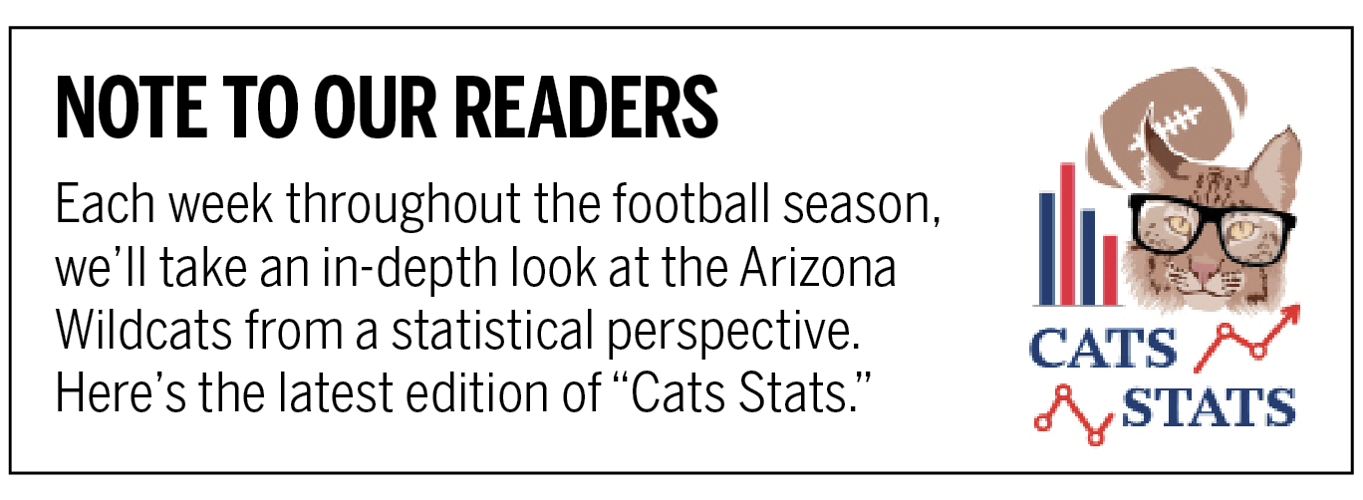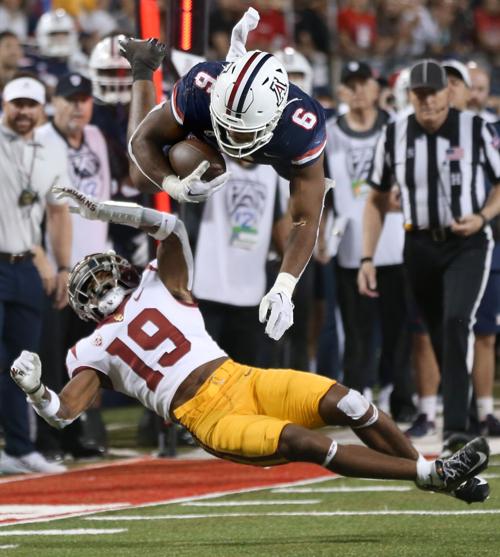Arizona ranks second in the Pac-12 and seventh in the nation in passing offense. The Wildcats even average more passing yards per game (328.0) than Mike Leach-coached Mississippi State (325.6).
So why would anyone want Arizona to run the ball more? Why are we about to make that case in this week’s UCLA edition of “Cats Stats”?
Let’s start with a string of numbers (two can play at this game, Coach Fisch): 20, 26, 12, 18, 17, 15, 25, 29, 16.
Those are the number of quarterback pressures each of the Wildcats’ opponents has generated this season, according to Pro Football Focus. In six instances, UA foes exceeded their season average. San Diego State basically hit it (20 vs. 20.1).

If you’ve been watching Arizona closely, you know that it’s taken some absolute sorcery from QB Jayden de Laura to prevent those pressures from turning into a boatload of sacks. Utah got to him three times last week, including an instance where de Laura tried his patented spin move and the Utes saw it coming.
We asked Brennan Carroll, Arizona’s offensive coordinator and offensive line coach, what effect a productive ground game — like the one the Wildcats flashed in Salt Lake City — could have on an opponent’s pass rush.
“A huge one,” Carroll said.
He added: “Obviously, when they gotta honor the run, they can’t sit back there and cover all the receivers. We’ll just keep working to find the best ways to attack it, and hopefully we can have some more success.”
Arizona had great success running the ball against Utah. Running backs combined for 143 yards on 15 carries. A lot of that came on chunk plays, such as Michael Wiley’s 57-yard run, but so what? It’s not like that’s a bad thing.
You can make the argument that the Wildcats’ backs are an underutilized resource. Wiley leads the group with a per-game average of 11.9 touches (rushes plus receptions). Jonah Coleman is next at 7.8 (although he’s been limited the past two games). DJ Williams is third at 6.1.
Meanwhile, the top four rushers in the Pac-12 — UCLA’s Zach Charbonnet, USC’s Travis Dye, Arizona State’s Xazavian Valladay and Cal’s Jaydn Ott — all average more carries per game than Wiley does total touches.
Every team has different styles and systems, of course. While some lean heavily on one runner, others – such as Arizona – use more of a committee approach.
The Wildcats have a deep RB room, and it just got deeper with the return of freshman Rayshon Luke. Arizona also has a deep, talented receiving corps — one of the top three units in the conference — and those mouths need to be fed too.
We’ve previously rebuked the idea that the Wildcats should run the ball more by pointing out that what they were doing was working. One off night in difficult conditions at Utah doesn’t change that.
Jedd Fisch would be foolish to ignore Jacob Cowing, Dorian Singer, Tetairoa McMillan and Tanner McLachlan. Those four and de Laura are the main reason Arizona has raised its scoring output by nearly two touchdowns per game.
Cowing, who ranks in the top two in the conference in receptions, yards and touchdowns, is questionable for the UCLA game after hurting his knee against Utah. Fisch should have an update on Cowing’s status Thursday.
Some stats suggest Arizona should throw the ball against UCLA. Cornerback might be a vulnerable area for the Bruins. Per PFF, their top cover guy, Devin Kirkwood, ranks 26th among Pac-12 cornerbacks in reception rate against at 60.5% (minimum 90 coverage snaps). Jaylin Davies is at 65.4%. Former Wildcat Azizi Hearn is at 66.7%.
UCLA ranks seventh in the league in pass defense, fifth in run defense. But in terms of average gain allowed per pass attempt, the Bruins are second behind Oregon State. They’ve allowed only 21 pass plays of 20-plus yards, tied for 11th best in the country.
Why might that be? UCLA gets after the quarterback. The Bruins are tied for fourth in the conference with 22 sacks. Their top-graded defenders per PFF are edge rushers Laiatu Latu and Gabriel Murphy. They’ve combined for 65 QB pressures.
(Murphy’s twin brother, Grayson, has 34. The three of them have 99 pressures. The entire UA defense has 95.)
Next week’s opponent, Washington State, ranks third in the Pac-12 with 23 sacks.
Which brings us back to our initial point: One of the best ways to slow down a good pass rush is by running the ball.
Fisch has directed a more pass-heavy offense this season than last. We can look at that in two ways.
The first is via sack-adjusted rushing and passing attempts. NCAA accounting places sacks in the rush-attempt category. They obviously aren’t rushing plays. So, doing that math, Arizona has passed the ball 60.3% of the time this season. Last year the Wildcats threw it 55% of the time.
Keep in mind, Arizona had different personnel last season. Fisch and his staff overhauled the skill positions. But it’s also worth noting that the Wildcats weren’t as competitive last year and frequently faced sizable deficits – which, in theory, should have led to more passing.
The second way of looking at run/pass ratios is to factor in scrambles — QB runs that aren’t by design. PFF tracks those. De Laura has scrambled 30 times this season. Shifting those to the pass column, Arizona’s pass rate jumps to 65.1%. Last year’s scramble-adjusted rate was 60.4%.
Meanwhile, despite having fewer than 30 carries in each game, the Wildcats rushed for more than 150 yards against USC and Utah. It was the first time Arizona had posted back-to-back games with 150-plus rushing yards since Weeks 2 and 3 of 2019.
We’re not suggesting the UA suddenly morph into North Dakota State. But shifting maybe a half-dozen plays from the pass column to the run column could benefit the team in multiple ways.
That includes aiding the beleaguered Arizona defense, at least theoretically. Utah had 55 rushing attempts (out of 80 plays) and dominated time of possession. The Wildcats have won time of possession only two times this season, in lopsided wins over San Diego State and Colorado.
Of course, doing that is contingent on converting third downs and preventing the opposition from converting. The Wildcats were 3 of 11 vs the Utes. Utah was 8 of 12. That led to a disparity of 25 total plays — by far Arizona’s largest deficit this season.
If you live in Arizona, it's only right that you should know a few facts about our fair state. Play along with this quiz and see if you can correctly answer five questions about the Grand Canyon State!






